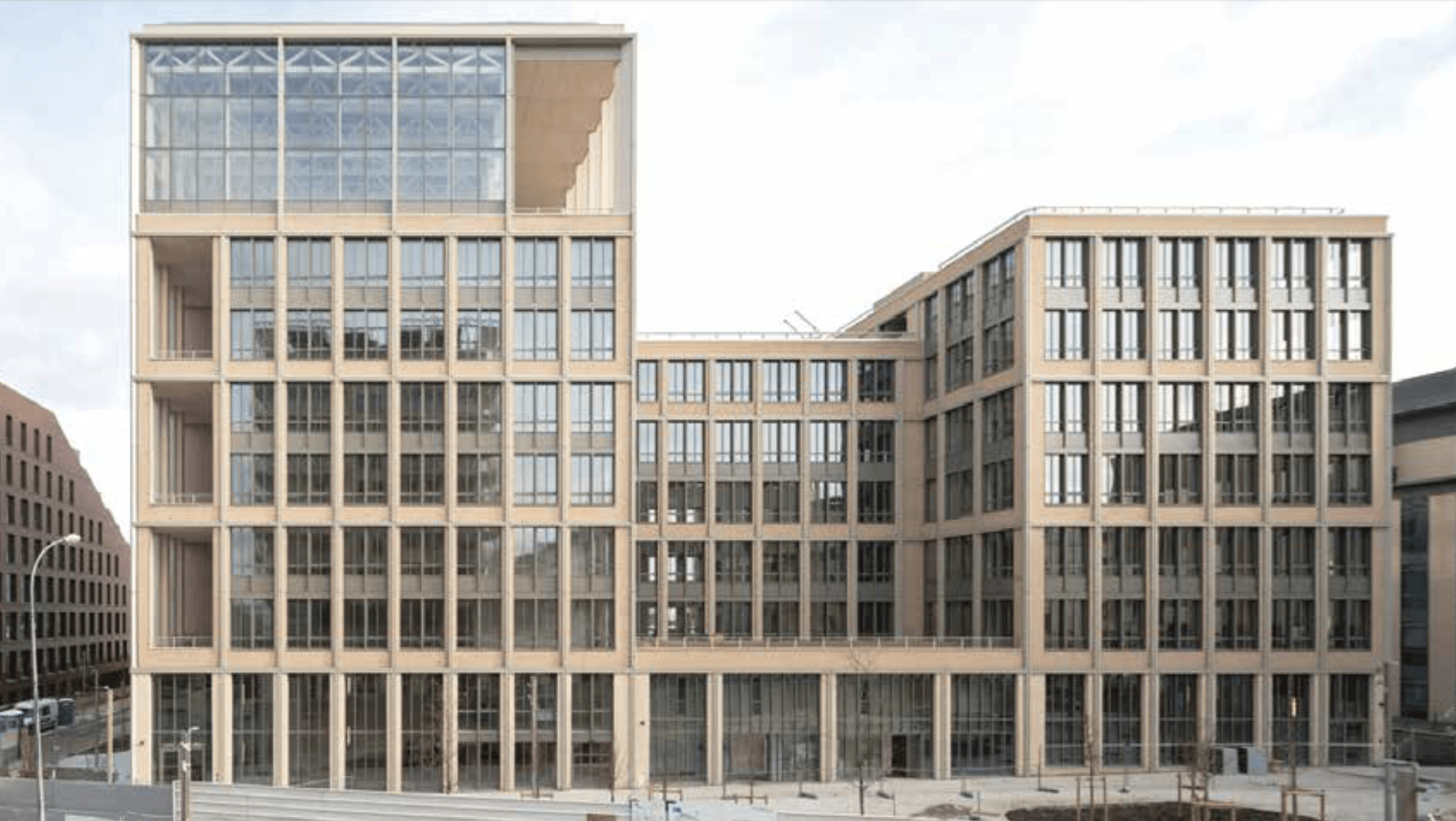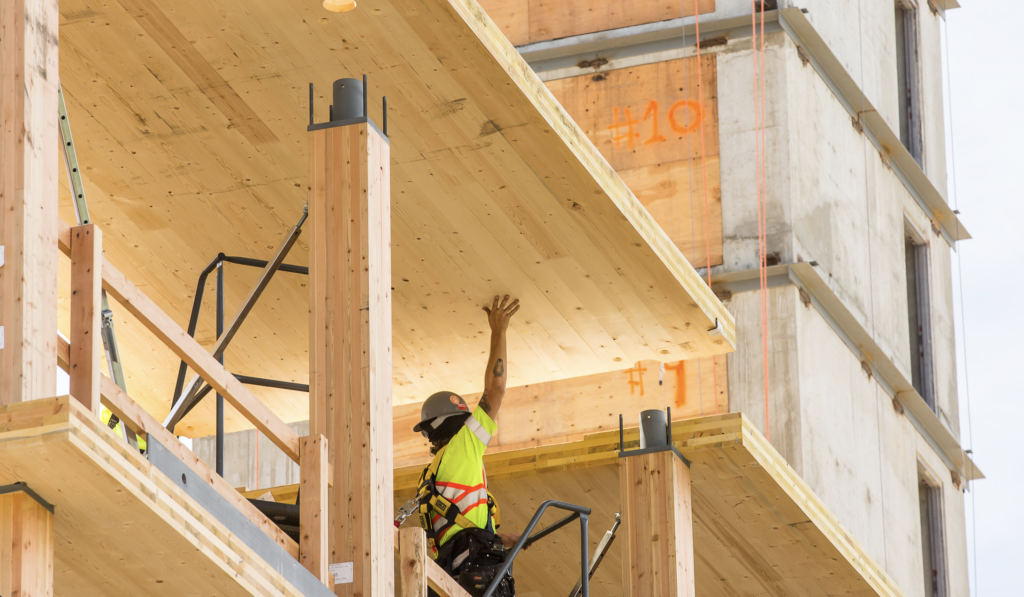Building a Sustainable Future: Scaling Canada’s Mass Timber Sector
 The mass timber office building in the Paris Olympics Athlete’s Village/Dezeen
The mass timber office building in the Paris Olympics Athlete’s Village/Dezeen
By Dr. Bentley Allan and Dr. Derek Eaton
September 16, 2024
If you watched the 2024 Summer Olympics, you may have noticed something different about the Paris Olympic Village landmarks visible in the coverage. From the saddle-shaped Aquatics Centre (prefabricated in a village near the German border) to the athletes’ residences, to the main Athlete’s Village office building (above), the Paris games were an unprecedented global showcase for mass timber. As Bloomberg noted in its coverage of Paris’s novel, sustainable approach to Olympic architecture, “The potential advantages of building in wood are legion.”
Canada’s mass timber industry is ready to seize mass timber’s international moment, and close the gap with European leaders. The sector is already on the cusp of significant expansion, with the potential to revolutionize both our construction industry and our human landscape. More than a decade of work has already unlocked and demonstrated the advantages of mass timber, from its potential to support the drive to net-zero, to its role in addressing the housing crisis and the jobs it can create in rural and Indigenous communities.
The term “mass timber” describes a class of engineered, wood-based structural building materials increasingly used in residential construction and large-scale infrastructure projects. The range of mass timber products includes cross-laminated timber (CLT), glued laminated timber (glulam), nail-laminated timber (NLT), dowel-laminated timber (DLT), mass plywood panels (MPP), laminated veneer lumber (LVL), parallel strand lumber (PSL), and laminated strand lumber (LSL).
With nearly 700 mass timber buildings completed in Canada and at least 140 more projects under construction or in planning stages, the burgeoning local and international demand for mass timber beams, panels and buildings underscores the industry’s capacity to add substantial value to our forest sector. However, there is still crucial work ahead.
Canada boasts excellent wood resources and supply chain expertise. To build on that foundation and develop a world-class mass timber sector, industry and government must adopt a strategic approach to forestry resource utilization. Instead of a commodity-based, volume-driven approach, we should view our forests as a national resource that can drive economic diversification. As an alternative to, and enhancement of, conventional building materials, mass timber presents a unique means of contributing to three crucial goals:
1. Addressing the housing crisis: Initially recognized for “tall wood” buildings and showpiece non-residential structures, mass timber is now primed to become a mainstream material of choice in residential applications, especially in the 4-6 storey range and more common 7-12 storey buildings, including hybrid structures that combine wood with steel and concrete. Mass timber designs, especially those incorporating prefabrication and modular approaches, offer a promising strategy to construct multi-unit residential structures more quickly and cost-effectively. Prefabrication allows entire wall assemblies to be manufactured and customized offsite, significantly shortening construction times by up to 20 percent and reducing costs.
2. Creating good jobs in rural and Indigenous communities: Mass timber can revitalize rural and Indigenous communities, creating good jobs and integrating these communities into a future economy which, too often, Canada’s resource workers feel left out of. Mass timber offers a pathway to ensure these communities benefit from the net-zero transition.
3. Supporting net-zero buildings: Mass timber reduces the carbon intensity of construction by lowering emissions from conventional materials and by providing long-term carbon storage. Using wood products alongside other cost-effective decisions can reduce embodied carbon by as much as 40 percent, significantly lowering the overall lifecycle emissions of buildings.
 Mass timber construction can reduce embodied carbon by as much as 40%/Adobe
Mass timber construction can reduce embodied carbon by as much as 40%/Adobe
Recognizing mass timber’s social and economic benefits, countries worldwide are racing to seize the opportunities it offers in the transition to a net-zero world. Canada, however, is falling behind. Many domestic mass timber projects source products like CLT panels from Europe rather than local manufacturers. To compete globally, Canada needs an efficient, integrated forest-to-buildings value chain. Transforming primary resources into high-value products incorporating innovative technologies and advanced skills is crucial for Canada’s long-term economic success. Capturing manufacturing value-added can increase productivity and drive growth, providing net-zero building solutions and green jobs to forestry communities.
Our Vision and Roadmap
To address these challenges, in 2023, the Forest Products Association of Canada(FPAC), the Canadian Wood Council (CWC), the Energy Futures Lab (EFL) and the Transition Accelerator convened more than 50 participants from Canada’s mass timber value chain, representing business, government, research institutions, Indigenous communities, and non-governmental organizations (NGOs). Over a series of workshops, these participants worked together to co-create The Mass Timber Roadmap for an integrated forest-to-buildings supply chain in Canada.
This ambitious plan envisions increasing the mass timber market to $1.2 billion by 2030 and $2.4 billion by 2035, reflecting expected market growth in Canada and the US.
Critical Actions to Achieve the Vision
To achieve this, coordinated efforts must address three critical actions:
- Create a public-private collaboration to develop and advance a policy package that will add value to Canada’s forest resources while building homegrown capacity along the supply chain.
- Standardize building archetypes, wood specifications, and connectors across the whole supply chain.
- Develop and implement a skills development plan that covers all aspects of the supply chain.
To coordinate and clarify more specific actions, the roadmap divides the mass timber ecosystem into five workstreams, each with its own near-term goal, along with specific targets, goals and actions needed for each of these workstreams to advance the mass timber industry in Canada today:
- Forestry and Wood Supply: Advance mass-timber specific milling and drying needs while scoping out the transformative changes to harvesting and timber grading that would be needed to create an integrated mass timber supply chain.
- Manufacturing: Increase production capacity, including pre-manufacturing of lamina and billets, and prefabrication.
- Architecture, Building Codes, Design, and Fire Safety: Identify strategic niches for prefabricated connections and secure low-hanging-fruit changes in building codes.
- Construction: Drive the uptake of mass timber as mainstream material in construction and expand beyond one-off buildings into repeatable forms, large building markets, and hybrid construction.
- Policy, Programs, and Sustainability: Develop a policy package – with measures such as grants, tax incentives, R&D programs, and lifecycle analysis (LCA) synthesis, among others – that would help the industry scale-up while building homegrown capacity along the supply chain.
 Modular mass timber structures offer a cost-effective solution to Canada’s housing shortage/Adobe
Modular mass timber structures offer a cost-effective solution to Canada’s housing shortage/Adobe
A Call to Action: A Mass Timber Alliance
To scale, mass timber needs the right incentives to overcome a chicken-and-egg situation in the value chain. Manufacturers need to see market demand to justify large capital investments, while building designers and developers need assurance of timely supply of mass timber products.
Given the integrated and dynamic nature of the challenge, the actions in The Mass Timber Roadmap now need to be advanced by an alliance of industry and other stakeholders, working closely with governments. A coordinating council should oversee implementation of the roadmap, supported by individual task forces for each of the five respective workstreams.
We invite governments at various levels to play a critical role in the implementation of the roadmap. They need to be active participants in the process, as members of the council and task forces. The federal government and relevant provincial governments should treat the Mass Timber Roadmap process as a strategic priority initiative. Learning from international examples of successful initiatives, the implementation of the roadmap can best be approached as partnership between public and private sectors.
The Path Forward
Canada has a major opportunity to scale the mass timber sector in response to significant market demand, domestically and internationally. Not only does supporting this sector have the potential to provide significant economic and social benefits — generating regional economic development opportunities and skilled jobs while also playing a major role in addressing Canada’s housing shortfall — it can also contribute to Canada’s net-zero goals, combining faster and less-costly construction with reduced carbon footprints. Through intentional and concentrated effort now of businesses and other actors throughout the ecosystem, we can seize this opportunity to build a better, more prosperous, net-zero future for Canada.
Dr. Bentley Allan is Assistant Professor of Political Science at Johns Hopkins University, founder and co-director of the Net Zero Industrial Policy Lab and transition pathway principal for the Transition Accelerator.
Dr. Derek Eaton serves as Director of Future Economy for the Transition Accelerator.
